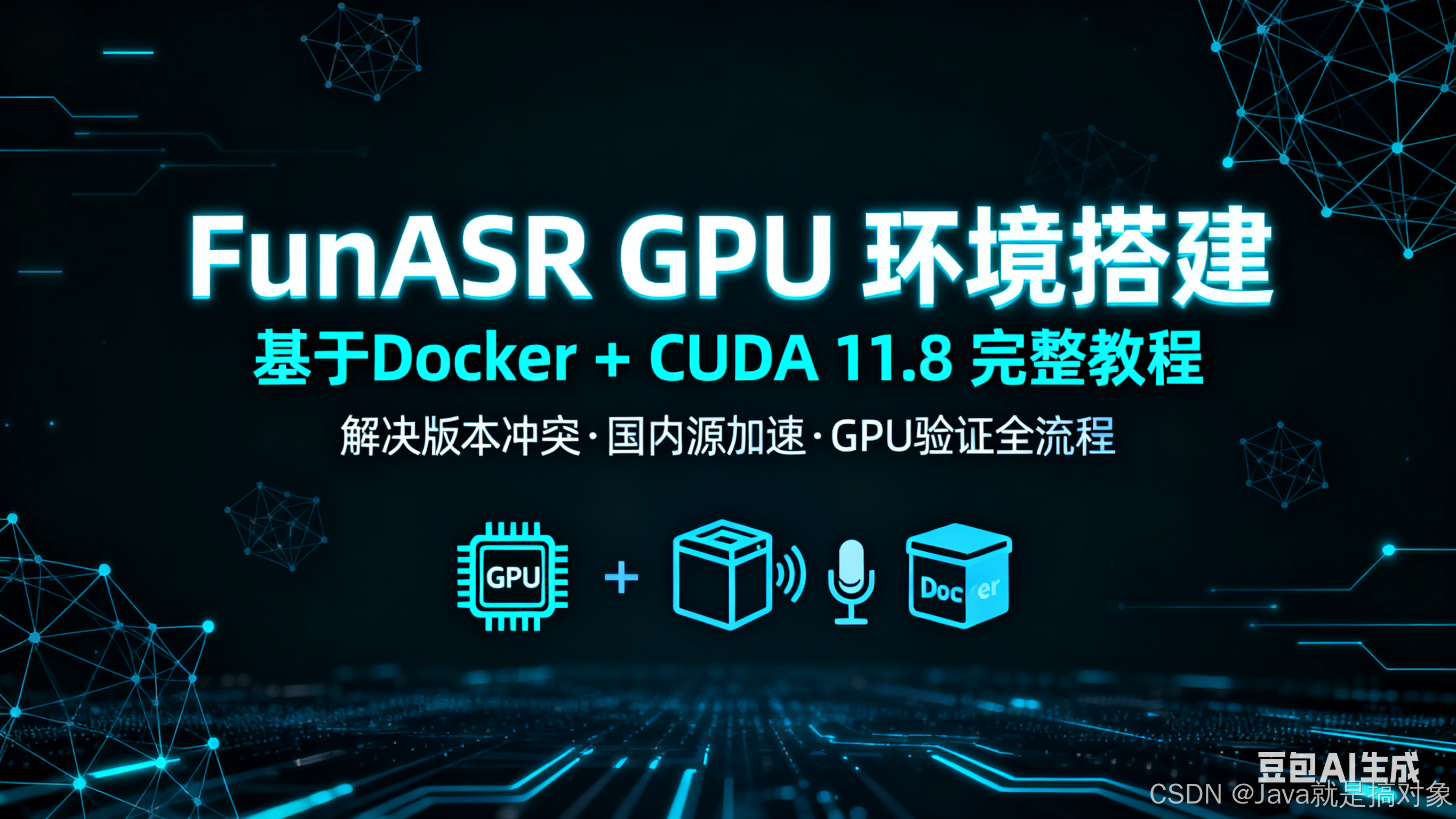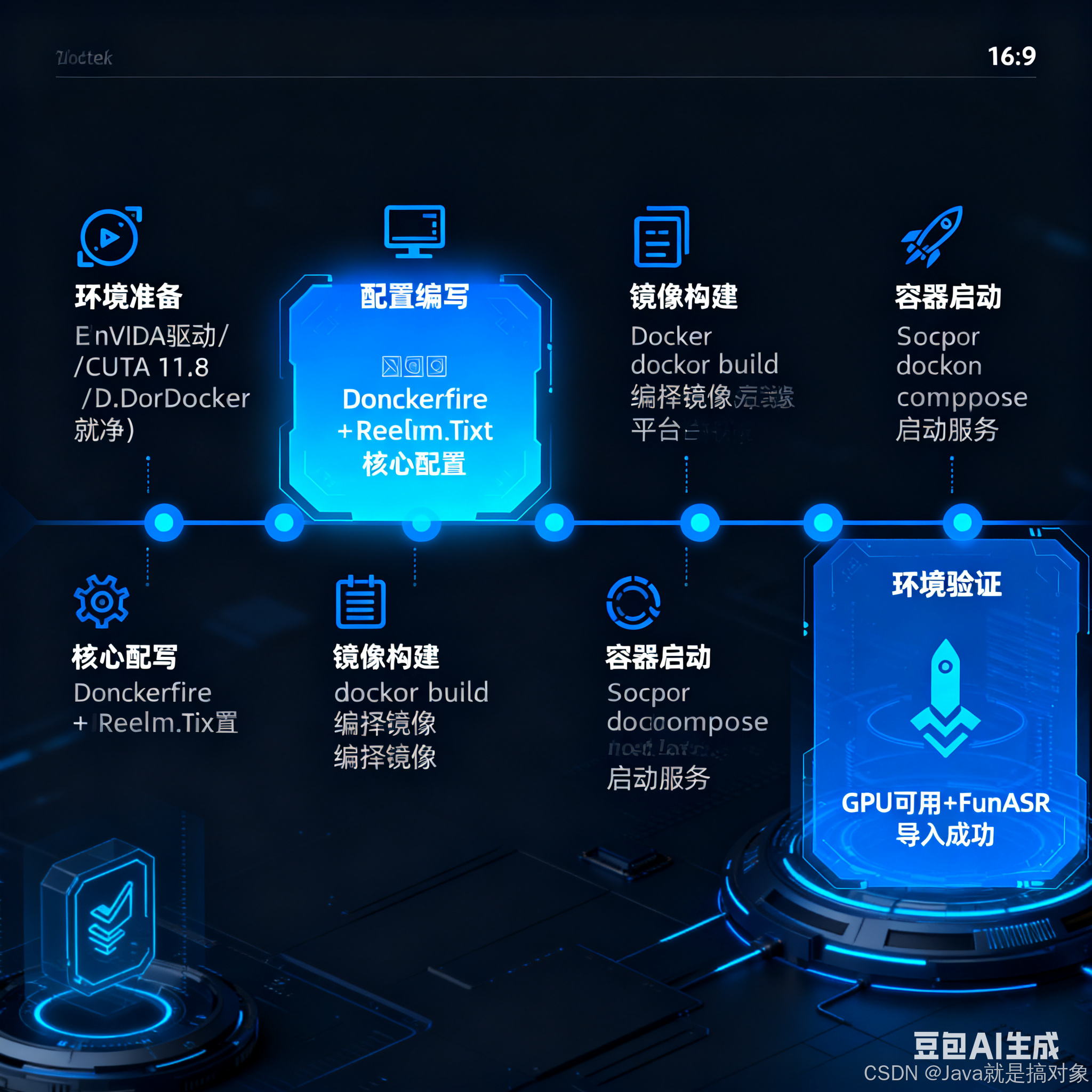FunASR GPU 环境 Docker 构建完整教程(基于 CUDA 11.8)

FunASR GPU环境Docker构建完整教程(基于CUDA 11.8)
一、教程目的
本文档详细介绍如何通过Docker构建支持GPU加速的FunASR环境,解决依赖版本兼容、国内源加速、模块缺失等问题,最终实现FunASR服务的正常启动与GPU验证。
二、环境准备
2.1 前提条件
- 操作系统:Ubuntu 22.04(推荐,与基础镜像版本一致)
- 硬件要求:NVIDIA显卡(支持CUDA 11.8,驱动版本≥520.61.05)
- 软件依赖:
- Docker Engine(20.10+)
- Docker Compose(2.10+)
- NVIDIA Container Toolkit(用于Docker GPU透传)
2.2 前期检查
确保NVIDIA驱动与CUDA 11.8兼容:
nvidia-smi # 输出中需包含 "CUDA Version: 11.8" 或更高兼容版本
确保Docker能识别GPU:
docker run --rm --gpus all nvidia/cuda:11.8.0-cudnn8-runtime-ubuntu22.04 nvidia-smi

三、核心配置文件编写
3.1 Dockerfile配置(最终稳定版)
创建Dockerfile,按以下内容编写(关键步骤含注释说明):
# 1. 基础镜像:CUDA 11.8 + CuDNN 8(自带CuDNN,无需额外安装,减少依赖冲突)
FROM nvidia/cuda:11.8.0-cudnn8-runtime-ubuntu22.04# 2. 替换Ubuntu apt源为阿里云(加速系统依赖下载,解决官方源超时问题)
RUN sed -i s@/archive.ubuntu.com/@/mirrors.aliyun.com/@g /etc/apt/sources.list && \sed -i s@/security.ubuntu.com/@/mirrors.aliyun.com/@g /etc/apt/sources.list# 3. 安装基础工具(合并命令减少Docker分层,清理缓存减少镜像体积)
RUN apt-get update && apt-get install -y --no-install-recommends \python3 python3-pip ffmpeg # ffmpeg为FunASR音频处理依赖 \&& ln -s /usr/bin/python3 /usr/bin/python # 建立python软链接,统一命令 \&& rm -rf /var/lib/apt/lists/* # 清理apt缓存 \# 4. 配置pip全局使用清华源(国内加速,避免官方源下载慢)&& pip config set global.index-url https://pypi.tuna.tsinghua.edu.cn/simple \&& pip config set global.trusted-host pypi.tuna.tsinghua.edu.cn \# 5. 升级pip(解决旧版本pip安装依赖时的兼容性问题)&& pip install --upgrade pip --default-timeout=1000# 6. 安装GPU版PyTorch(版本2.1.0+cu118已验证:官方源存在+兼容CUDA 11.8+Python 3.10)
# --no-deps:禁用自动依赖,避免下载与CuDNN冲突的nvidia-cudnn-cu12
# -f:指定PyTorch官方CUDA 11.8源,确保版本存在
RUN pip install torch==2.1.0+cu118 torchvision==0.16.0+cu118 torchaudio==2.1.0+cu118 \--no-deps \-f https://download.pytorch.org/whl/cu118/torch_stable.html \--default-timeout=1000# 7. 创建FunASR模型目录并设置权限(避免运行时权限不足)
RUN mkdir -p /models && chmod -R 777 /models# 8. 暴露服务端口(需与Docker Compose配置一致,此处为FunASR默认端口示例)
EXPOSE 5102# 9. 设置工作目录+复制代码+安装项目依赖
WORKDIR /funAsr
COPY . . # 将本地FunASR代码复制到容器内
# 安装项目依赖,延长超时时间应对大文件下载
RUN pip install -r requirements.txt --default-timeout=1000 -f https://download.pytorch.org/whl/cu118/torch_stable.html# 10. 启动FunASR服务(根据实际启动脚本调整,此处为app.py示例)
CMD ["python", "app.py"]
3.2 requirements.txt配置(最终稳定版)
创建requirements.txt,解决版本冲突、NumPy兼容、FunASR缺失问题:
# 音频处理依赖
ffmpeg_python
# Web服务依赖
Flask
Flask_Cors
flask_restx==1.3.0 # 指定版本避免兼容性问题
# 语音识别依赖(Whisper)
openai_whisper==20240930
# 网络请求依赖
Requests
# PyTorch系列(与Dockerfile版本严格一致!避免重复下载与冲突)
torch==2.1.0+cu118
torchvision==0.16.0+cu118
torchaudio==2.1.0+cu118
# Web服务依赖
Werkzeug
# FunASR核心依赖( kaldifst用于语音特征处理)
kaldifst
# 异步服务依赖
gevent
# NumPy降级至1.x(解决旧模块编译兼容问题,避免"_ARRAY_API not found"警告)
numpy<2
# FunASR主依赖(关键!之前缺失导致ModuleNotFoundError)
funasr==1.0.4 # 指定稳定版本,参考官方推荐
四、镜像构建与容器验证
4.1 构建Docker镜像
# 1. 清理旧镜像与构建缓存(避免历史缓存干扰,首次构建可跳过)
docker rmi funasr:latest
docker builder prune -f# 2. 构建镜像(--no-cache:不使用缓存,确保依赖最新;-t:指定镜像名)
docker build --no-cache -t funasr:latest .
4.2 启动容器(以Docker Compose为例)
若使用docker-compose.yml(需与Dockerfile端口一致):
version: "3.8"
services:funasr:image: funasr:latestcontainer_name: ai-funasrrestart: alwaysports:- "5102:5102" # 端口映射:主机端口:容器端口volumes:- ./models:/models # 模型目录挂载(可选,持久化模型)deploy:resources:reservations:devices:- driver: nvidiacount: all # 使用所有GPUcapabilities: [gpu] # 启用GPU能力
启动命令:
docker-compose up -d funasr
4.3 验证环境正确性
4.3.1 验证GPU是否可用
# 进入容器执行PyTorch GPU检测命令
docker exec -it ai-funasr python -c "import torch; print('GPU可用:', torch.cuda.is_available()); print('PyTorch版本:', torch.__version__); print('CUDA版本:', torch.version.cuda)"
预期输出(无警告且GPU可用):
GPU可用: True
PyTorch版本: 2.1.0+cu118
CUDA版本: 11.8
4.3.2 验证FunASR依赖是否正常
# 验证funasr模块可导入
docker exec -it ai-funasr python -c "from funasr import AutoModel; print('FunASR导入成功')"
预期输出:
FunASR导入成功
4.3.3 查看服务日志(排查启动异常)
docker logs -f ai-funasr
若日志无ModuleNotFoundError、CUDA error等报错,且显示“Service started”等启动成功信息,则环境正常。
五、常见问题解决(FAQ)
5.1 问题1:PyTorch版本找不到(ERROR: No matching distribution)
错误现象
ERROR: Could not find a version that satisfies the requirement torch==2.2.1+cu118 (from versions: ...)
原因
- 指定的PyTorch版本(如2.2.1+cu118)在当前源中不存在;
- 源地址错误(如清华Anaconda源无cu118版本)。
解决方案
- 改用PyTorch官方CUDA 11.8源(
-f https://download.pytorch.org/whl/cu118/torch_stable.html); - 选择已验证存在的版本(如
torch==2.1.0+cu118),参考官方源查询结果。
5.2 问题2:requirements.txt与Dockerfile PyTorch版本不一致
错误现象
Dockerfile安装torch==2.1.0+cu118,但requirements.txt指定torch==2.2.1+cu118,导致构建失败。
原因
两处版本未统一,pip安装依赖时试图覆盖安装不存在的版本。
解决方案
- 确保
requirements.txt中PyTorch系列版本与Dockerfile完全一致(如均为2.1.0+cu118)。
5.3 问题3:NumPy兼容警告(_ARRAY_API not found)
错误现象
A module that was compiled using NumPy 1.x cannot be run in NumPy 2.2.6...
原因
NumPy 2.x与旧模块(如PyTorch组件、kaldifst)编译不兼容。
解决方案
- 在
requirements.txt中添加numpy<2,强制使用NumPy 1.x版本。
5.4 问题4:FunASR模块缺失(ModuleNotFoundError: No module named ‘funasr’)
错误现象
File "/funAsr/app.py", line 11, in <module> from funasr import AutoModel
ModuleNotFoundError: No module named 'funasr'
原因
requirements.txt中遗漏funasr依赖。
解决方案
- 在
requirements.txt中添加funasr==1.0.4(或官方推荐版本)。
六、注意事项
6.1 NVIDIA容器许可协议
- 使用
nvidia/cuda基础镜像即表示接受《NVIDIA Deep Learning Container License》; - 许可详情可查看容器内文件:
docker exec -it ai-funasr cat /NGC-DL-CONTAINER-LICENSE,或访问官方许可页面。
6.2 root用户运行风险
- 容器内默认以
root用户运行pip,会提示警告:Running pip as the 'root' user can result in broken permissions; - 建议:生产环境中在Dockerfile内创建普通用户(如
RUN useradd -m funasr && su funasr),避免root权限风险。
6.3 国内源稳定性
- 清华PyPI源(
https://pypi.tuna.tsinghua.edu.cn/simple)偶尔可能出现“网页解析失败”或“系统内部异常”; - 备用方案:改用阿里云PyPI源(
https://mirrors.aliyun.com/pypi/simple/),在Dockerfile中修改pip config set global.index-url即可。
6.4 版本兼容性优先
- 避免盲目追求新版本:PyTorch选择
2.1.0+cu118、FunASR选择1.0.4均为“验证过兼容”的版本; - 升级建议:若需升级版本,先通过
curl -s https://download.pytorch.org/whl/cu118/torch_stable.html | grep "torch-.*cu118"确认版本存在,再修改配置。
6.5 构建缓存清理
- 每次修改
Dockerfile或requirements.txt后,建议执行docker builder prune -f清理缓存; - 避免旧缓存导致新配置不生效(如依赖未更新、版本未替换)。
